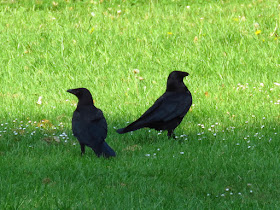Stock Doves are so intriguing. A combination of shyness and a superficial resemblance to feral pigeons makes them often pass unnoticed. Several times this spring I have watched them in flight, usually a pair, sometimes trios, with one of the doves flying right above another, their wings almost touching, but there didn't seem to be aggression in the behaviour. What are they doing?
I might have found the answer today, reading an old article by Derek Goodwin. He describes a behaviour called 'driving' which is present in several members of the pigeon family, including the domestic pigeon. This is his description:
The driving cock follows his mate everywhere, often literally "treading on her tail". He pecks, usually in a gentle manner, but sometimes fiercely, at her head. If the hen takes wing he flies closely behind and above her. If she goes to the nest (domestic birds) the male stops driving.
Pigeon breeders thought that driving meant that the male pigeon wanted the female to go to nest, given that when the female goes to the nest the driving stops. Goodwin disagreed with this interpretation and thought instead that driving allowed the male to keep the female away from suitors, either on the ground or in flight.
In the two photos illustrating this post, a third pigeon was flying out of frame. I presume the male is the individual above, intercepting the female from the male.
Goodwin observations were consistent with this, as driving happened when other males were near the female, in particular during a period before egg laying and ended once the first egg has been laid, that is, a period when the female is sexually receptive, so that the behaviour is the way the male keeps the female away of competitors, and is effectively a form of mate guarding, as he put it 'It functions to prevent insemination of the female by males other than her own mate. Interference with copulating pairs is part of the same behaviour-complex as driving and has a like causation and function.' When, occasionally, driving was observed with just the pair involved, he thought that the male had succeeded in his driving:
I have seen a pair fly up from some crowded feeding ground, and the male, who was at first driving hard in flight, swing out beside or in front of his mate as they got well away from others in the air, usually going into display flight as he did so.
More information










